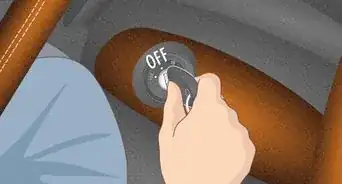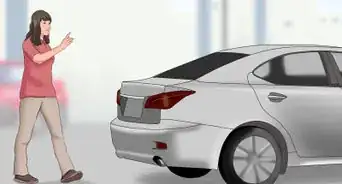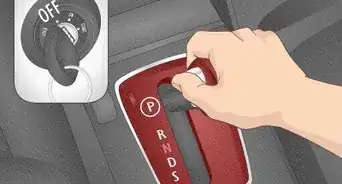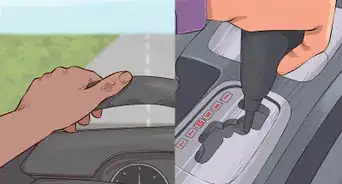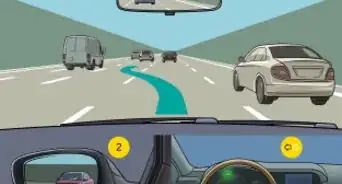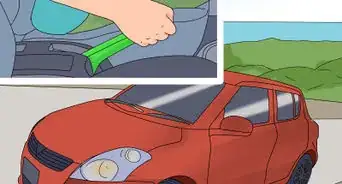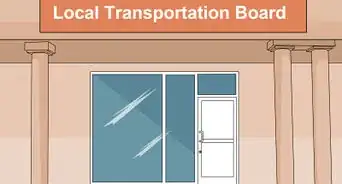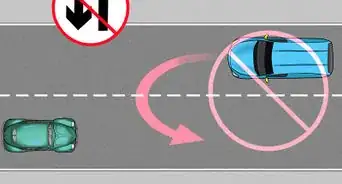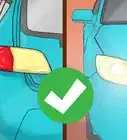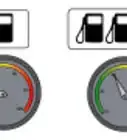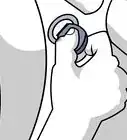This article was co-authored by Simon Miyerov. Simon Miyerov is the President and Driving Instructor for Drive Rite Academy, a driving academy based out of New York City. Simon has over 8 years of driving instruction experience. His mission is to ensure the safety of everyday drivers and continue to make New York a safer and efficient driving environment.
There are 8 references cited in this article, which can be found at the bottom of the page.
wikiHow marks an article as reader-approved once it receives enough positive feedback. This article received 13 testimonials and 88% of readers who voted found it helpful, earning it our reader-approved status.
This article has been viewed 637,925 times.
Merging onto the highway is one of the more stressful lessons we all learn in driver's ed. Because highway conditions (and other drivers) are unpredictable, it's difficult to apply the same rules to any given situation. Understanding traffic laws and having good driving reflexes are key to merging on the highway safely. See Step 1 to learn all you need to know about how to merge without crashing.
Steps
Using the Right Technique
-
1Building up speed. The first step of merging safely is to make sure you're travelling at the same speed as the traffic on the highway. Use the acceleration lane - the entrance ramp or place where you're entering the highway - to quickly gain speed.[1]
- Merging at the same speed as the other highway traffic will ensure that you don't create a dangerous situation when you merge, with vehicles approaching very fast.
- Look in your mirrors and pay attention to the other cars while you're accelerating. You may need to wait a beat or two before accelerating to full speed if you see a line of cars coming up quickly in the lane into which you're trying to merge.
-
2Use your indicator. Do it early, so other drivers can see your intentions. This gives them time to make any necessary adjustments. However, keep in mind that as the person merging, you don't have the right of way. Other drivers are not expected to move out of the way; rather, they'll continue going at the same speed, and it's up to you to make sure you adjust your speed and merge safely.[2]Advertisement
-
3Look for a gap in traffic. If traffic on the highway is heavy, you'll have to find a gap before you merge. Keep your eyes on the road, but check your mirrors and look behind you to figure out when it is safe to go. At the same time, maintain an appropriate speed to allow you to merge safely into the flow of traffic.[3]
- Look in the rearview mirror, then at your driver's side mirror.
- Glance to see that there is no vehicle in your blind spot (close behind you in the lane that you are merging).
- Check whether someone has slowed or stopped in the ramp/merge lane in front of you.
-
4Merge when it's safe to do so. When you see a gap, ease your car into the lane. You should now be driving at the same speed as the rest of the traffic. Pay attention to the cars around you as you merge; you'll need to be able to react quickly if someone brakes in front of you or tries to enter your lane.
Practicing Good Merging Habits
-
1Check other cars' "body language". Technically, cars in the merging lane are supposed to continue at the same speed, making it the responsibility of the person merging to find a gap and ease into it. However, every driver behaves a little differently, so it's important to pay attention to what's going on and make decisions based on reality.
- If you see a car behind you that seems to be slowing down, the driver is probably trying to "let you in"; accelerate and take the person up on the favor. The same goes if you notice cars moving out of the merge lane to make room for you.
- If you see a car that seems to be speeding up, let the person pass before trying to merge.
- Sometimes drivers will wave you in with their hands, too.
- Never assume others will use the correct speed. It's up to you to react to what happens.
-
2Create gaps in front and behind you. As you merge, you want to maintain a nice distance from the cars behind you and in front of you. This provides a little buffer in case the car in front of you brakes, forcing you to suddenly slow down. Practice accelerating at just the right speed, so that you're not coming up on cars too quickly or slowing things down behind you.[4]
-
3Never merge abruptly. Do your best not to jut into the lane into which you're trying to merge. Other drivers might not see you. Make sure you use your turn signal, and make eye contact if possible.[5]
-
4Don't come to a stop in the merge lane. If traffic is bad and you don't see any gaps, you might be tempted to come to a stop. This is not a good idea, because it takes too long for a car to accelerate from 0 to 65; when you try to start moving again, it'll be dangerous for both you and the other drivers. By putting your turn signal on right away, accelerating to the speed of traffic, and making eye contact with the driver behind you, you should be able to create a gap.[6]
-
5Be kind when you see others merging. Ease off the gas a bit if someone's trying to merge onto the highway in front of you, or speed up if that's the safer option. Stay alert and try to make things easier for the other drivers - it makes the highway safer for everyone.[7]
Expert Q&A
-
QuestionShould you drive a brand new car on the highway?
 Simon MiyerovSimon Miyerov is the President and Driving Instructor for Drive Rite Academy, a driving academy based out of New York City. Simon has over 8 years of driving instruction experience. His mission is to ensure the safety of everyday drivers and continue to make New York a safer and efficient driving environment.
Simon MiyerovSimon Miyerov is the President and Driving Instructor for Drive Rite Academy, a driving academy based out of New York City. Simon has over 8 years of driving instruction experience. His mission is to ensure the safety of everyday drivers and continue to make New York a safer and efficient driving environment.
Driving Instructor Sure, it's not a problem. The only thing I recommend is to make sure you know everything about the mechanics of the vehicle, especially if the weather is not the best possible. Also, be more careful since you're probably not too familiar with the mirrors as much as you should and you might have issues with blind spots.
Sure, it's not a problem. The only thing I recommend is to make sure you know everything about the mechanics of the vehicle, especially if the weather is not the best possible. Also, be more careful since you're probably not too familiar with the mirrors as much as you should and you might have issues with blind spots. -
QuestionHow do I drive on the highway?
 Community AnswerDrive at the speed limit. Stay in the right lane unless you are passing a slower vehicle. Be aware of traffic merging onto the highway.
Community AnswerDrive at the speed limit. Stay in the right lane unless you are passing a slower vehicle. Be aware of traffic merging onto the highway. -
QuestionHow can I change lanes on a two lane road?
 Community AnswerTo change lanes on a two lane road, first check your blind spot (to do this you have to physically turn your head and look back to whichever side the lane is that you're planning on merging into, as an entire semi truck can fit into the blind spot not shown by your mirrors) and, when traffic is clear, you must put on your turn signal in the direction of the lane change, and then you ease your car into the other lane. You need to be sure not to jerk the wheel too hastily to whichever direction you are changing lanes in so you don't go too far.
Community AnswerTo change lanes on a two lane road, first check your blind spot (to do this you have to physically turn your head and look back to whichever side the lane is that you're planning on merging into, as an entire semi truck can fit into the blind spot not shown by your mirrors) and, when traffic is clear, you must put on your turn signal in the direction of the lane change, and then you ease your car into the other lane. You need to be sure not to jerk the wheel too hastily to whichever direction you are changing lanes in so you don't go too far.
Warnings
- Watch out for vehicles merging into your lane. Many entrances onto a highway are also the exit for the road you just came from.⧼thumbs_response⧽
- Remember that other drivers may be behind you also trying to merge. Try to provide them space to merge into as well, by moving another lane over if possible.⧼thumbs_response⧽
- Sometimes, there may be no merge area at the end of the ramp. This will be clearly indicated by signs such as "No Merge Area" or "Yield". In this case you might have to slow down or even stop to make sure you are going to merge into an empty spot in the next lane.⧼thumbs_response⧽
- Don't forget to put your turn signal on. It is the best signal to the traffic in the merging lane of what you are about to do.⧼thumbs_response⧽
References
- ↑ https://driversedguru.com/drivers-ed-training-exercises/stage-4/stage-4-highway-merging/
- ↑ https://driving-tests.org/beginner-drivers/how-to-drive-on-the-highway/
- ↑ https://www.youtube.com/watch?v=v-OmDGydsHc
- ↑ https://www.dmv.ca.gov/portal/dmv/detail/pubs/hdbk/merg_pass
- ↑ https://www.edmunds.com/driving-tips/car-merging-psychology-dont-hate-the-sidezoomer.html
- ↑ https://driversedguru.com/drivers-ed-training-exercises/stage-4/stage-4-highway-merging/
- ↑ http://roadwarrior.blogs.pressdemocrat.com/10864/tips-for-merging-into-highway-traffic-and-surviving/?tc=ar
- ↑ https://www.youtube.com/watch?v=dYUxQPrpCsY
- https://www.qld.gov.au/transport/safety/rules/road/lanes
About This Article
To merge onto the highway without crashing, start by accelerating as you approach the highway so you’re going the same speed as the rest of the traffic by the time you need to merge. Then, use your turn signal to let the other drivers know you want to change lanes. After that, begin looking for a gap in the traffic by checking your side and rearview mirrors. When you see a gap, ease your car into the lane, and make sure to pay attention to the cars around you in case someone brakes in front of you or tries to enter your lane. For tips on how to create a gap in traffic when you don’t immediately see one, keep reading!


